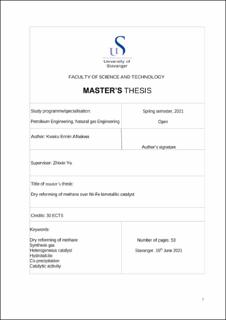| dc.description.abstract | Our climate is changing for the worse as the concentration of greenhouse gases in the atmosphere increases. Climate change is one of the most important challenges of our time. Emissions of greenhouse gases (GHG) have been rising steadily since the industrial revolution because of the increased use of fossil fuels. Today, there is a well-established scientific link between the concentration of GHG in the atmosphere and the average temperature on earth. Much research has been conducted to study how effectively these emissions can be reduced drastically. Among many others, one way of doing that is the utilization of the CO2 by reforming of methane to produce synthesis gas which can be valorised in the production of several chemicals such as methanol, ammonia, synthetic gasoline etc.
Heterogenous catalyst is mostly used for dry reforming of methane (DRM). Developing a stable, active, and cheap catalyst is being a major obstacle in the industry for a long time. Bimetallic Ni-Fe catalysts derived from hydrotalcite materials have been reported to be promising for the DRM reaction. The hydrotalcite (HT) materials possess high surface areas, high thermal stability, and uniform distribution of active metals.
This thesis focuses on the study and synthesis of several bimetallic Ni-Fe HT derived catalyst with Fe/Ni molar ratio ranging from 0.05 to 0.3. In each of these catalysts, the Ni loading remained constant at 20 wt.%. After the preparation of these catalysts, they were characterized by X-ray diffraction (XRD), nitrogen adsorption-desorption, temperature programmed reduction (TPR) and temperature programmed desorption (TPD).
Preparation was carried out using co-precipitation at high supersaturation method followed by calcination. All of the catalysts showed promising results, the hydrotalcite-like materials were successfully achieved and were confirmed by XRD patterns.
The catalytic activity of each of the samples prepared was studied in a DRM reaction at 700 oC in a fixed bed reactor. With a gas hourly space velocity (GHSV) of 300,000 mLg-1h-1, the catalyst with the Fe/Ni molar ratio of 0.15, CAT-0.15 was determined as the best sample due to its high conversions and stability. The final CH4 and CO2 conversions of this catalyst were 52% and 65% respectively and a final H2/CO of 0.76. The catalyst remained stable for the whole 24 h period of the reaction. | |
